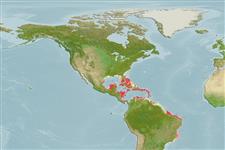>
Gobiiformes (Gobies) >
Gobiidae (Gobies) > Gobiinae
Etymology: Coryphopterus: Greek, koryphe = summit + Greek, pteron = fin, wing (Ref. 45335).
More on authors: Böhlke & Robins.
Environment: milieu / climate zone / depth range / distribution range
Ökologie
seewasser riff-verbunden; tiefenbereich 3 - 20 m (Ref. 9710). Subtropical
Western Atlantic: southern Florida in USA and Bahamas to southeastern Brazil (Ref. 51894).
Size / Gewicht / Alter
Maturity: Lm ? range ? - ? cm
Max length : 5.0 cm TL Männchen/unbestimmt; (Ref. 7251)
Rückenflossenstacheln (insgesamt) : 6; Rückenflossenweichstrahlen (insgesamt) : 9 - 10; Afterflossenstacheln: 1; Afterflossenweichstrahlen: 10; Wirbelzahl: 26. Pelvic frenum absent. Innermost pelvic-fin rays branched, connected to the ray of the opposite side by a basal membrane and smaller than immediately adjacent one (66 - 77% of its length). Elongate spine in the first dorsal fin absent. No spot above opercle (Ref. 52312).
Two distinct dark spots, one above other, on pectoral fin base (Ref. 26938). With numerous small brown spots, the largest a series of 6 along lower side, and small pale blue-green flecks; horizontal dark lines on head, the most prominent posterior to eye; a vertical blackish line or two blackish spots at base of caudal fin (Ref. 13442).
Inhabits coral reefs, tide pools, limestone caves, algae-covered rocks and isolated patch reefs surrounded by white sand (Ref. 5521).
Life cycle and mating behavior
Geschlechtsreife | Fortpflanzung | Ablaichen | Eier | Fecundity | Larven
Robins, C.R. and G.C. Ray, 1986. A field guide to Atlantic coast fishes of North America. Houghton Mifflin Company, Boston, U.S.A. 354 p. (Ref. 7251)
IUCN Rote Liste Status (Ref. 130435: Version 2024-2)
Bedrohung für Menschen
Harmless
Nutzung durch Menschen
Fischereien: kommerziell; Aquarium: Kommerziell
Tools
Zusatzinformationen
Download XML
Internet Quellen
Estimates based on models
Preferred temperature (Ref.
123201): 26 - 28.2, mean 27.4 °C (based on 697 cells).
Phylogenetic diversity index (Ref.
82804): PD
50 = 0.5001 [Uniqueness, from 0.5 = low to 2.0 = high].
Bayesian length-weight: a=0.00724 (0.00339 - 0.01546), b=3.10 (2.92 - 3.28), in cm total length, based on LWR estimates for this (Sub)family-body shape (Ref.
93245).
Trophic level (Ref.
69278): 2.7 ±0.4 se; based on size and trophs of closest relatives
Widerstandsfähigkeit (Ref.
120179): hoch, Verdopplung der Population dauert weniger als 15 Monate. (Preliminary K or Fecundity.).
Fishing Vulnerability (Ref.
59153): Low vulnerability (10 of 100).
Nutrients (Ref.
124155): Calcium = 167 [61, 418] mg/100g; Iron = 1.12 [0.47, 2.51] mg/100g; Protein = 18.3 [16.2, 20.2] %; Omega3 = 0.139 [0.053, 0.328] g/100g; Selenium = 12.3 [4.2, 35.1] μg/100g; VitaminA = 70.8 [13.6, 328.3] μg/100g; Zinc = 2.15 [1.19, 3.71] mg/100g (wet weight);
